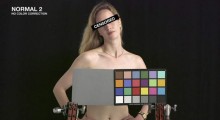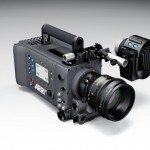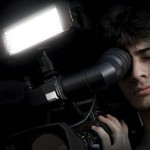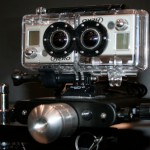Cinematography
-
Bryce Dallas Howard Directors Canon EOS C300 Short
Here is a just-posted short science-fiction film, When You Find Me, directed by Bryce Dallas Howard and produced by Ron Howard. It’s short on Canon’s new EOS C300 camera. As Koo notes over at No Film School, the short was inspired by a photograph submitted as part of Canon’s Project Imagination contest.
by Scott Macaulay on Dec 18, 2011 -
Jared Flesher on Doc Filmmaking with a DSLR: Part Two
In part 1 of this interview, filmmaker Jared Flesher talked about his latest project, Sourlands, and making the switch to a large sensor DSLR camera. In part 2, Jared talks about how he works as a one-man crew, other equipment he uses, finishing the project, and what future camera he might like to use: You were your own crew for this documentary? Part of my style of filmmaking is to be a one0-man film team. There are practical reasons for that. I’m working on a fairly limited budget, so if I don’t have to pay a sound man, or someone […]
by Michael Murie on Dec 17, 2011 -
Jared Flesher on Doc Filmmaking with a DSLR: Part One
Jared Flesher is a self-taught filmmaker. He shot his first feature-length documentary, The Farmer and The Horse on a Canon consumer camcorder, shooting and editing the entire movie himself. With the success of that movie under his belt, he moved on to his second documentary, Sourlands, which he just finished shooting and hopes to complete by June of 2012. For this movie he decided to make the switch to a larger sensor camera, and chose the Panasonic GH2. In the first part of this interview, Jared talks about why he made the movie, and his experience making the switch to […]
by Michael Murie on Dec 12, 2011 -
Is Shallow Depth-of-Field a Fad?

Most creative arts suffer from trends. Someone does something new or unusual, and suddenly dozens of others are imitating it; just look at Hollywood. Since the arrival of the Canon 5D Mark II, shallow depth-of-field has become almost a fetish. There’s certainly valid reasons to want to have shallow depth-of-field, as filmmaker Stu Maschwitz wrote on his blog: “With a 5D Mark II, its sensor double the size of a motion picture film frame, we can achieve cinematic focus at F4. We can get fetishistically shallow depth of field at F2.8. At F1.2, we can create abstract art in a […]
by Michael Murie on Dec 8, 2011 -
Jonathan Yi Talks About The Canon C300

Last week Jonathan Yi posted a video on the web: “Canon EOS C300 = Awesome”. The video, shot with a prototype of the new Canon C300, pokes fun at camera tests, while also demonstrating many of the capabilities of this camera. Though it was originally produced for Canon’s launch event, the video was not posted at that time because, as Jonathan said “Canon, not thrilled with my sense of humor, does not credit or condone this video.” Canon may have underestimated the charm of the video, or the interest in anything related to the C300; to date, the video has […]
by Michael Murie on Dec 5, 2011 -
The ARRI Alexa: Bridging Past and Future

Originally published in the Fall 2010 issue. The time frame needed to produce an independent feature these days can seem longer than the lifespan of its underlying technology. Cheap HDSLRs challenge high-end camcorders that cost 50 times more. Even RED One, whose revolutionary bona fides were golden two years ago, suddenly feels status quo. And lurking around the corner — due at year’s end — is a vanguard of new, inexpensive large-sensor camcorders from all the usual suspects. It’s been said that the geek shall inherit the earth, but this is getting ridiculous. How’s a producer to make sense of […]
by David Leitner on Dec 4, 2011 -
HIGH BEAMS

Originally published in the Spring 2009 issue. Although cameras always seem to attract the most interest, lighting (and the correct use of it) is perhaps the most vital aspect of the cinematographer’s craft. The major innovation of the lighting front in the last few years has been the appearance of LEDs. LED (light-emitting diode) technology has been around for almost 40 years, however, so what’s new about it that impacts the movie-making industry? Only in recent years has the technology advanced to the point where LED light sources can provide enough illumination for movie lighting. The attraction is obvious: LED […]
by Robert Render Harrison on Dec 4, 2011 -
The Software Camera
We’ve seen several revolutions in the world of camera design over the past ten years; HD video, solid state recording, DSLRs, and large sensor cameras, but one that is often overlooked is the arrival of the software camera. It used to be that when a camera was released its features were set in stone, and only the arrival of a new model – or a very rare recall – saw any changes in the capabilities of the camera. That has changed as the computer-like functionality of video cameras has expanded. As just one example, there were two amazing things about […]
by Michael Murie on Nov 28, 2011 -
Leitner’s Mondo NAB, Part 5: Roundup

Originally posted April 2011. This fifth and last NAB 2011 blog is really about churn. Churn, to my way of thinking, is the degree of agitation and upheaval in the industry at a given point in time, such as this NAB. Apple’s sneak peek of FCP X at the Final Cut Pro Users Group 10th anniversary SuperMeet reminded me that even a decade ago, indie filmmakers were still coming to grips with the desktop revolution. I remember producers transferring MiniDV cassettes of my footage to Betacam for digitizing back to Avid, oblivious to FireWire or FCP 1.0. How professional could […]
by David Leitner on Nov 27, 2011 -
Leitner’s Mondo NAB, Part 4: 3D

Originally posted April 2011. NAB’s ubiquitous buzzwords this year were 3D and 4K. Or should that be, buzz-acronyms? James Cameron and camera design partner Vince Pace kicked off NAB with a keynote in which they announced founding a new company, Cameron-Pace Group, to spur the industry, particularly television, into rapid adoption of 3D technologies. Cameron, who knows a thing or two about being on top of the world, may have it right again. He and Pace think that TV is fertile soil for 3D, that in a space of five years TV viewers will expect 3D. By then, they contend, […]
by David Leitner on Nov 27, 2011






